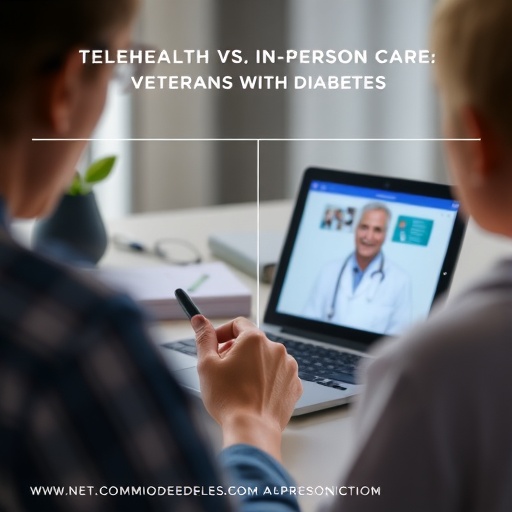In an increasingly digital world, healthcare systems worldwide are rapidly transitioning towards telehealth services. This shift has become particularly poignant in the context of older veterans, a demographic often experiencing a myriad of health challenges, including diabetes. A recent study by Syed et al., published in the Journal of General Internal Medicine, investigates the comparative outcomes of telehealth versus traditional in-person medical encounters among older veterans with diabetes. The research not only sheds light on patient engagement and satisfaction but also delves into the clinical implications of this healthcare delivery model in an aging population plagued by chronic diseases.
As we understand it, telehealth encompasses a broad array of technologies and services that facilitate remote healthcare. The advent of telehealth has revolutionized how patients interact with medical professionals, especially during and post the COVID-19 pandemic when in-person visits became limited. Veterans, many of whom reside in rural areas with insufficient access to healthcare facilities, have found telehealth to be an indispensable tool in their ongoing battle against chronic conditions like diabetes. The study’s findings prompt a reevaluation of traditional care paradigms, challenging preconceived notions about the superiority of face-to-face interactions.
The primary objective of the study was to analyze clinical outcomes from both telehealth and in-person consultations, benchmarking those outcomes against a variety of metrics vital to managing diabetes. Patients who engaged with their healthcare providers via telehealth reported not only similar but in some cases improved satisfaction levels when compared to their in-person visits. This is a significant finding that suggests that telehealth may fulfill many of the needs specific to the geriatric population while accommodating their often limited mobility and access challenges.
Furthermore, the study articulated the importance of continuity in care management, detailing how telehealth can facilitate ongoing communication between patients and healthcare providers. Veterans have unique health considerations, with many experiencing comorbidities that necessitate regular monitoring. The ability to conduct follow-up consultations via telehealth can enhance adherence to treatment plans. This continuous dialogue promotes better self-management of diabetes, ultimately leading to improved clinical outcomes.
Another essential aspect covered in the research is the role of patient education through telehealth. Veterans participating in the study emphasized the effectiveness of online resources and virtual consultations in understanding their condition. This newfound accessibility to information empowers patients by promoting a proactive approach to their health, which is indispensable in managing chronic diseases. Improved patient education can lead to heightened awareness and proactive management strategies, critical components for diabetes control.
In contrast, the study also highlighted certain challenges associated with telehealth. For instance, technological issues such as internet connectivity and the accessibility of devices may pose significant barriers for some older veterans. Additionally, not all patients may feel comfortable using technology, indicating a potential gap that healthcare providers need to bridge. Tailoring telehealth solutions to meet the specific needs of the older population will be an essential component in optimizing its effectiveness.
The research’s design involved a cross-sectional analysis, drawing data from a substantial cohort of older veterans. By carefully evaluating key health indicators and patient-reported outcomes, this multi-faceted investigation provides robust insights into how telehealth compares with in-person care. The authors meticulously detail various parameters, including glycemic control, frequency of hospitalizations, and overall patient satisfaction levels, offering a comprehensive view of the implications of telehealth on diabetes management.
Furthermore, it’s imperative to recognize the impact of the COVID-19 pandemic, which has fundamentally altered the landscape of healthcare delivery. The unprecedented health crisis accelerated the adoption of telehealth, compelling healthcare providers to adapt rapidly to remote care models. The study’s findings contribute invaluable data on how this evolution may redefine the patient experience in the long term, especially for vulnerable populations. The pandemic underscored the necessity for flexible healthcare solutions capable of maintaining continuity of care amidst disruptions in traditional modalities.
As policymakers and healthcare institutions evaluate the repercussions of transitioning to telehealth ontologies, understanding nuanced clinical outcomes becomes essential. Syed et al. advocate for the integration of telehealth as a standard practice in managing chronic conditions like diabetes among older veterans. As this demographic continues to grow, ensuring their access to effective healthcare solutions will be crucial in improving health outcomes.
Telehealth’s potential benefits extend beyond patient satisfaction and clinical outcomes; it also may prove to be a more cost-effective model for healthcare delivery. By minimizing the need for in-person visits, healthcare systems can allocate resources more efficiently, ultimately leading to a reduction in overall healthcare costs. This economic factor is particularly significant in the context of an aging population that often incurs higher healthcare expenditures due to chronic disease management.
In conclusion, as the healthcare landscape evolves, the study by Syed et al. serves as a compelling case for embracing telehealth as a viable alternative to traditional in-person encounters. By carefully examining the management of diabetes in older veterans, it raises important questions about how healthcare providers can best meet the needs of this population going forward. The promising results suggest that telehealth can effectively complement traditional care, paving the way for enhanced patient engagement, satisfaction, and clinical outcomes.
The integration of telehealth into routine patient care represents a paradigm shift, necessitating ongoing research to optimize its implementation in varied contexts. Future studies will be crucial in determining the long-term effects of telehealth on chronic disease management, particularly for vulnerable demographics like older veterans. Ultimately, the future of healthcare may very well hinge on our ability to leverage technology to better serve those in need.
Subject of Research: Comparative outcomes of telehealth and in-person encounters in older veterans with diabetes.
Article Title: Comparative Analysis of Clinical Outcomes Related to Telehealth and In-Person Encounters Among Older Veterans with Diabetes.
Article References:
Syed, Q., McGwin, G., Johnson, T. et al. Comparative Analysis of Clinical Outcomes Related to Telehealth and In-Person Encounters Among Older Veterans with Diabetes.
J GEN INTERN MED (2025). https://doi.org/10.1007/s11606-025-09871-2
Image Credits: AI Generated
DOI: 10.1007/s11606-025-09871-2
Keywords: telehealth, diabetes management, older veterans, patient outcomes, healthcare delivery.




